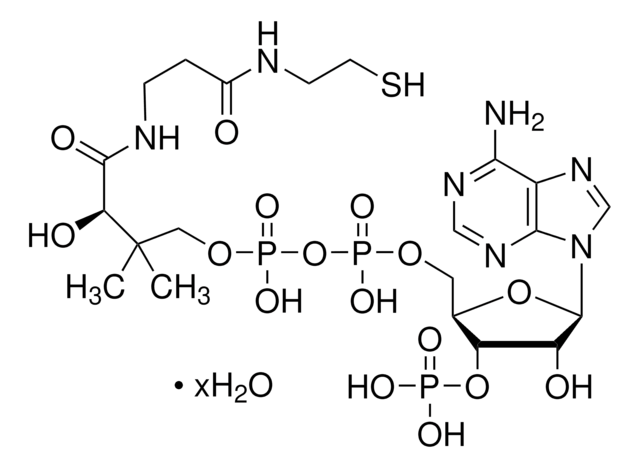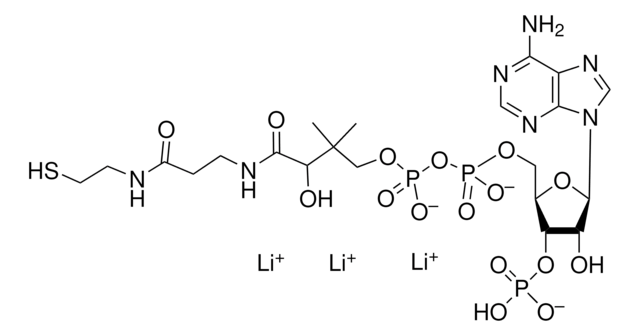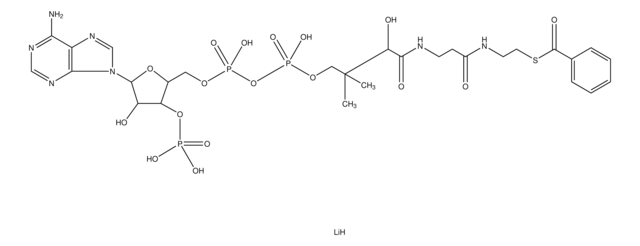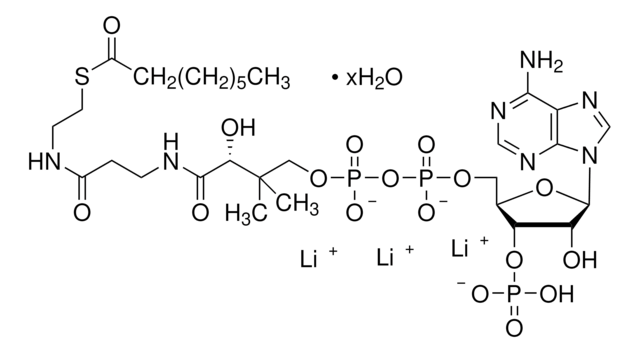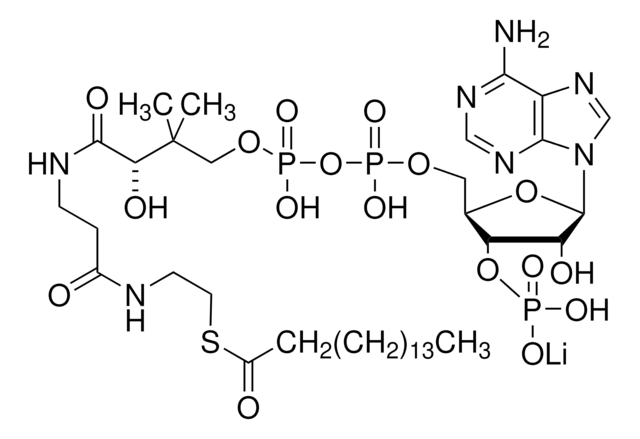C4780
Coenzyme A sodium salt hydrate
BioReagent, suitable for cell culture
Synonym(s):
CoA Na2
Sign Into View Organizational & Contract Pricing
All Photos(4)
About This Item
Empirical Formula (Hill Notation):
C21H36N7O16P3S · xNa+ · yH2O
CAS Number:
Molecular Weight:
767.53 (anhydrous free acid basis)
EC Number:
UNSPSC Code:
12352205
PubChem Substance ID:
NACRES:
NA.75
Recommended Products
biological source
yeast
Quality Level
description
cofactor for acyl transfer
product line
BioReagent
Assay
≥85% (HPLC)
form
powder
technique(s)
cell culture | mammalian: suitable
solubility
water: 50 mg/mL, clear, colorless to faintly yellow
storage temp.
−20°C
SMILES string
[Na+].CC(C)(COP(O)(=O)OP(O)(=O)OC[C@H]1O[C@H]([C@H](O)[C@@H]1OP(O)([O-])=O)n2cnc3c(N)ncnc23)C(O)C(=O)NCCC(=O)NCCS
InChI key
SYTRWOCXZXQBPW-CLVRNSBASA-M
Looking for similar products? Visit Product Comparison Guide
Application
Coenzyme A sodium salt hydrate has been used:
- in the branch chain aminotransferase enzymatic assay and protein determination
- in the assay for halogenation of pyrrolyl-S-Bmp1 (an acyl carrier protein (ACP)-thioesterase (TE) di-domain protein) by Bmp2
- as an extracellular coenzyme A (CoA) in in vitro and in vivo experiments to study alternative routes by which cells and organisms can obtain CoA
Biochem/physiol Actions
Coenzyme A (CoA) is a ubiquitous cofactor that plays an important role in many metabolic pathways, mainly as acyl-CoA. It is essential for the tricarboxylic acid cycle, and the synthesis and oxidation of fatty acids. CoA facilitates acyl group transfers, especially in fatty acid and lipid metabolism reactions. It is associated with neurodegeneration, autophagy, protein acetylation, and signal transduction.
Quality
Enzymatically assayed using phosphotransacetylase. Approx. 95% CoA-SH
Storage Class Code
11 - Combustible Solids
WGK
WGK 3
Flash Point(F)
Not applicable
Flash Point(C)
Not applicable
Personal Protective Equipment
dust mask type N95 (US), Eyeshields, Gloves
Choose from one of the most recent versions:
Already Own This Product?
Find documentation for the products that you have recently purchased in the Document Library.
Customers Also Viewed
Balaji Srinivasan et al.
Nature chemical biology, 11(10), 784-792 (2015-09-01)
The metabolic cofactor coenzyme A (CoA) gained renewed attention because of its roles in neurodegeneration, protein acetylation, autophagy and signal transduction. The long-standing dogma is that eukaryotic cells obtain CoA exclusively via the uptake of extracellular precursors, especially vitamin B5
Le Tran Phuc Khoa et al.
Cell stem cell, 27(3), 441-458 (2020-07-02)
Self-renewing embryonic stem cells (ESCs) respond to environmental cues by exiting pluripotency or entering a quiescent state. The molecular basis underlying this fate choice remains unclear. Here, we show that histone acetyltransferase MOF plays a critical role in this process
Our team of scientists has experience in all areas of research including Life Science, Material Science, Chemical Synthesis, Chromatography, Analytical and many others.
Contact Technical Service